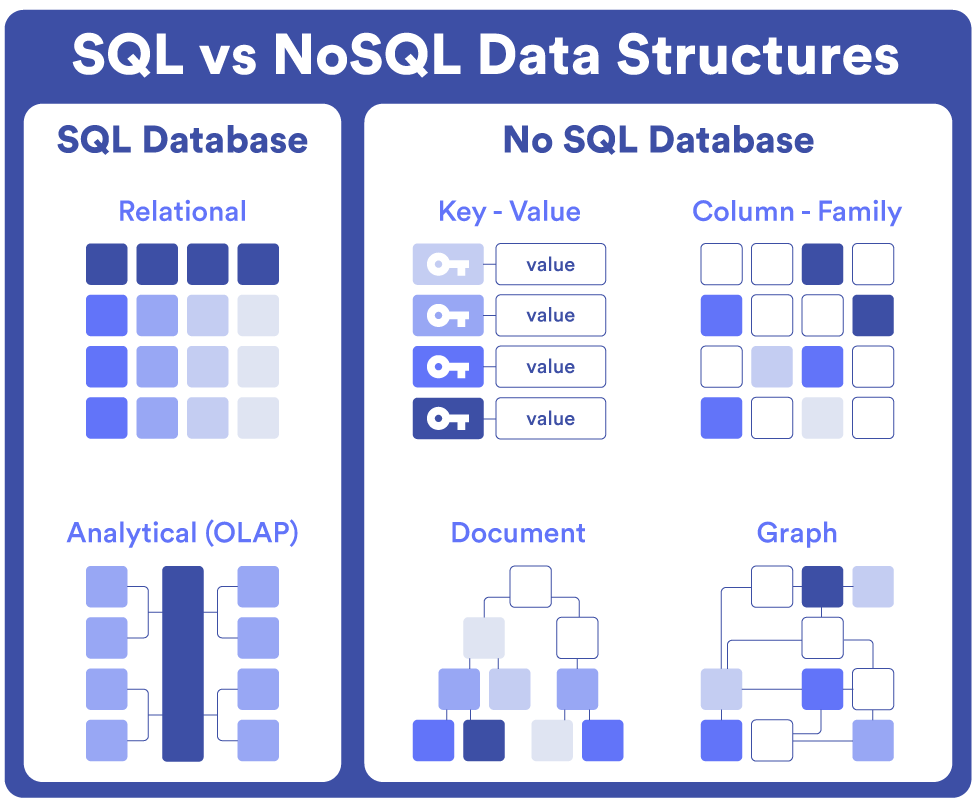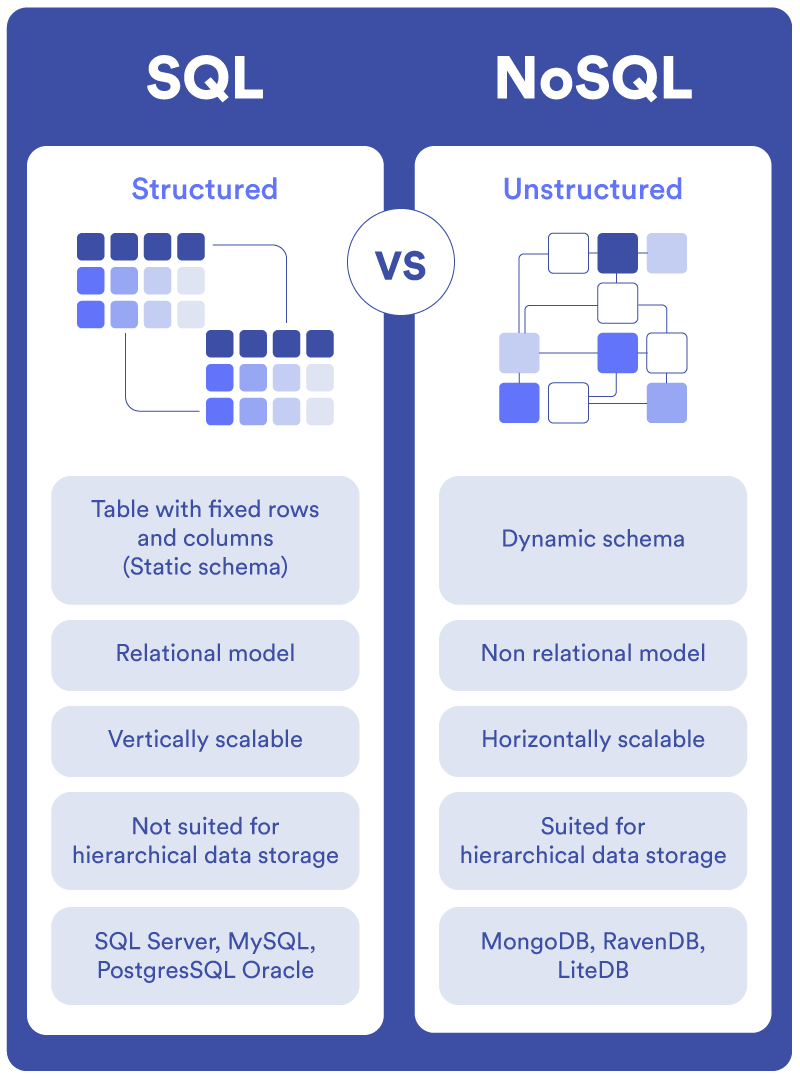Until recently, the default model for application development was SQL. However, in recent years NoSQL has become a popular alternative.
The wide variety of data that is stored today and the workload that servers must support force developers to consider other more flexible and scalable options. NoSQL databases provide agile development and ease of adapting to changes. Even so, they cannot be considered as a replacement for SQL nor are they the most successful choice for all types of projects.
Choosing between NoSQL vs SQL is an important decision, if you wish to avoid technical difficulties during the development of an application. In this article we aim to explore the differences between these two database management systems and guide readers on the use of each of them, taking into account the needs of the project and the type of data to be handled.
What is NoSQL?
The term NoSQL is short for “Not only SQL” and refers to a category of DBMSs that do not use SQL as their primary query language.
The NoSQL database boom began in 2000, matching the arrival of web 2.0. From then on, applications became more interactive and began to handle large volumes of data, often unstructured. Soon traditional databases fell short in terms of performance and scalability.
Big tech companies at the time decided to look for solutions to address their specific needs. Google was the first to launch a distributed and highly scalable DBMS: BigTable, in 2005. Two years later, Amazon announced the release of Dynamo DB (2007). These databases (and others that were appearing) did not use tables or a structured language, so they were much faster in data processing.
Currently, the NoSQL approach has become very popular due to the rise of Big Data and IoT devices, that generate huge amounts of data, both structured and unstructured.
Thanks to its performance and ability to handle different types of data, NoSQL managed to overcome many limitations present in the relational model. Netflix, Meta, Amazon or LinkedIn are examples of modern applications that use NoSQL database to manage structured information (transactions and payments) as well as unstructured information (comments, content recommendations and user profiles).
Difference between NoSQL and SQL
NoSQL and SQL are two database management systems (DBMS) that differ in the way they store, access and modify information.
The SQL system
SQL follows the relational model, formulated by E.F. Codd in 1970. This English scientist proposed replacing the hierarchical system used by the programmers of the time with a model in which data are stored in tables and related to each other through a common attribute known as “primary key”. Based on their ideas, IBM created SQL (Structured Query Language), the first language designed specifically for relational databases. The company tried unsuccessfully to develop its own RDBMS, so it had to wait until 1979, the year of the release of Oracle DB.
Relational databases turned out to be much more flexible than hierarchical systems and solved the issue of redundancy, following a process known as “normalization” that allows developers to expand or modify databases without having to change their whole structure. For example, an important function in SQL is JOIN, which allows developers to perform complex queries and combine data from different tables for analysis.
The NoSQL system
NoSQL databases are even more flexible than relational databases since they do not have a fixed structure. Instead, they employ a wide variety of models optimized for the specific requirements of the data they store: spreadsheets, text documents, emails, social media posts, etc.
Some data models that NoSQL uses are:
- Key-value: Redis, Amazon DynamoDB, Riak. They organize data into key and value pairs. They are very fast and scalable.
- Documentaries: MongoDB, Couchbase, CouchDB. They organize data into documents, usually in JSON format.
- Graph-oriented: Amazon Neptune, InfiniteGraph. They use graph structures to perform semantic queries and represent data such as nodes, edges, and properties.
- Column-oriented: Apache Cassandra. They are designed to store data in columns instead of rows as in SQL. Columns are arranged contiguously to improve read speed and allow efficient retrieval of the data subset.
- Databases in memory: They get rid of the need to access disks. They are used in applications that require microsecond response times or that have high traffic spikes.

In summary, to work with SQL databases, developers must first declare the structure and types of data they will use. In contrast, NoSQL is an open storage model that allows new types of data to be incorporated without this implying project restructuring.
Relational vs. non-relational database
To choose between an SQL or NoSQL database management system, you must carefully study the advantages and disadvantages of each of them.
Advantages of relational databases
- Data integrity: SQL databases apply a wide variety of restrictions in order to ensure that the information stored is accurate, complete and reliable at all times.
- Ability to perform complex queries: SQL offers programmers a variety of functions that allow them to perform complex queries involving multiple conditions or subqueries.
- Support: RDBMS have been around for decades; they have been extensively tested and have detailed and comprehensive documentation describing their functions.
Disadvantages of relational databases
- Difficulty handling unstructured data: SQL databases have been designed to store structured data in a relational table. This means they may have difficulties handling unstructured or semi-structured data such as JSON or XML documents.
- Limited performance: They are not optimized for complex and fast queries on large datasets. This can result in long response times and latency periods.
- Major investment: Working with SQL means taking on the cost of licenses. In addition, relational databases scale vertically, which implies that as a project grows, it is necessary to invest in more powerful servers with more RAM to increase the workload.
Advantages of non-relational databases
- Flexibility: NoSQL databases allow you to store and manage structured, semi-structured and unstructured data. Developers can change the data model in an agile way or work with different schemas according to the needs of the project.
- High performance: They are optimized to perform fast queries and work with large volumes of data in contexts where relational databases find limitations. A widely used programming paradigm in NoSQL databases such as MongoDB is “MapReduce” which allows developers to process huge amounts of data in batches, breaking them up into smaller chunks on different nodes in the cluster for later analysis.
- Availability: NoSQL uses a distributed architecture. The information is replicated on different remote or local servers to ensure that it will always be available.
- They avoid bottlenecks: In relational databases, each statement needs to be analyzed and optimized before being executed. If there are many requests at once, a bottleneck may take place, limiting the system’s ability to continue processing new requests. Instead, NoSQL databases distribute the workload across multiple nodes in the cluster. As there is no single point of entry for enquiries, the potential for bottlenecks is very low.
- Higher profitability: NoSQL offers fast and horizontal scalability thanks to its distributed architecture. Instead of investing in expensive servers, more nodes are added to the cluster to expand data processing capacity. In addition, many NoSQL databases are open source, which saves on licensing costs.
Disadvantages of NoSQL databases
- Restriction on complex queries: NoSQL databases lack a standard query language and may experience difficulties performing complex queries or require combining multiple datasets.
- Less coherence: NoSQL relaxes some of the consistency constraints of relational databases for greater performance and scalability.
- Less resources and documentation: Although NoSQL is constantly growing, the documentation available is little compared to that of relational databases that have been in operation for more years.
- Complex maintenance: Some NoSQL systems may require complex maintenance due to their distributed architecture and variety of configurations. This involves optimizing data distribution, load balancing, or troubleshooting network issues.
When to use SQL databases and when to use NoSQL?
The decision to use a relational or non-relational database will depend on the context. First, study the technical requirements of the application such as the amount and type of data to be used.
In general, it is recommended to use SQL databases in the following cases:
- If you are going to work with well-defined data structures, for example, a CRM or an inventory management system.
- If you are developing business applications, where data integrity is the most important: accounting programs, banking systems, etc.
In contrast, NoSQL is the most interesting option in these situations:
- If you are going to work with unstructured or semi-structured data such as JSON or XML documents.
- If you need to create applications that process data in real time and require low latency, for example, online games.
- When you want to store, manage and analyze large volumes of data in Big Data environments. In these cases, NoSQL databases offer horizontal scalability and the possibility of distributing the workload on multiple servers.
- When you launch a prototype of a NoSQL application, it provides you with fast and agile development.
In most cases, back-end developers decide to use a relational database, unless it is not feasible because the application handles a large amount of denormalized data or has very high performance needs.
In some cases it is possible to adopt a hybrid approach and use both types of databases.
SQL vs NoSQL Comparison
CTO Mark Smallcombe published an article titled “SQL vs NoSQL: 5 Critical Differences” where he details the differences between these two DBMS.
Below is a summary of the essentials of your article, along with other important considerations in comparing SQL vs NoSQL.

How data is stored
In relational databases, data are organized into a set of formally described tables and are related to each other through common identifiers that provide access, consultation and modification.
NoSQL databases store data in its original format. They do not have a predefined structure and can use documents, columns, graphs or a key-value schema.
Language
Relational databases use the SQL structured query language.
Non-relational databases have their own query languages and APIs. For example, MongoDB uses MongoDB Query Language (MQL) which is similar to JSON and Cassandra uses Cassandra Query Language (CQL) which looks like SQL, but is optimized for working with data in columns.
Compliance with ACID properties
Relational databases follow the ACID guidelines (atomicity, consistency, isolation, durability) that guarantee the integrity and validity of the data, even if unexpected errors occur. Adopting the ACID approach is a priority in applications that handle critical data, but it comes at a cost in terms of performance, since data must be written to disk before it is accessible.
NoSQL databases opt instead for the BASE model (basic availability, soft state, eventual consistency), which prioritizes performance over data integrity. A key concept is that of “eventual consistency”. Instead of waiting for the data to be written to disk, some degree of temporal inconsistency is tolerated, assuming that, although there may be a delay in change propagation, once the write operation is finished, all the nodes will have the same version of the data. This approach ensures faster data processing and is ideal in applications where performance is more important than consistency.
Vertical or horizontal scalability
Relational databases scale vertically by increasing server power.
Non-relational databases have a distributed architecture and scale horizontally by adding servers to the cluster. This feature makes NoSQL a more sustainable option for developing applications that handle a large volume of data.
Flexibility and adaptability to change
SQL databases follow strict programming schemes and require detailed planning as subsequent changes are often difficult to implement.
NoSQL databases provide a more flexible development model, allowing easy adaptation to changes without having to perform complex migrations. They are a practical option in agile environments where requirements change frequently.
Role of Pandora FMS in database management
Pandora FMS provides IT teams with advanced capabilities to monitor SQL and NoSQL databases, including MySQL, PostgreSQL, Oracle, and MongoDB, among others. In addition, it supports virtualization and cloud computing environments (e.g., Azure) to effectively manage cloud services and applications.
Some practical examples of the use of Pandora FMS in SQL and NoSQL databases:
- Optimize data distribution in NoSQL: It monitors performance and workload on cluster nodes avoiding overloads on individual nodes.
- Ensure data availability: It replicates the information in different nodes thus minimizing the risk of losses.
- Send Performance Alerts: It monitors server resources and sends alerts to administrators when it detects query errors or slow response times. This is especially useful in SQL databases whose performance depends on the power of the server where the data is stored.
- Encourage scalability: It allows you to add or remove nodes from the cluster and adjust the system requirements to the workload in applications that work with NoSQL database.
- Reduce Latency: It helps administrators identify and troubleshoot latency issues in applications that work with real-time data. For example, it allows you to adjust NoSQL database settings, such as the number of simultaneous connections or the size of the network buffer, thus improving query speed.
Conclusion
Making a correct choice of the type of database is key so that no setbacks arise during the development of a project and expand the possibilities of growth in the future.
Historically, SQL databases were the cornerstone of application programming, but the evolution of the Internet and the need to store large amounts of structured and unstructured data pushed developers to look for alternatives outside the relational model. NoSQL databases stand out for their flexibility and performance, although they are not a good alternative in environments where data integrity is paramount.
It is important to take some time to study the advantages and disadvantages of these two DBMSs. In addition, we must understand that both SQL and NoSQL databases require continuous maintenance to optimize their performance.
Pandora FMS provides administrators with the tools necessary to improve the operation of any type of database, making applications faster and more secure, which translates into a good experience for users.

I studied Philology, but life circumstances led me to work in the Marketing sector as a content writer. I am passionate about the world of blogging and the opportunity to learn that comes with each new project. I invite you to follow my posts on the Pandora FMS blog to discover the technological trends that are transforming the business world.

















